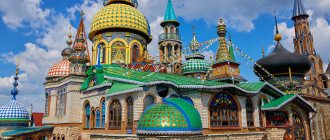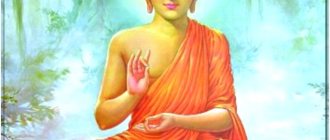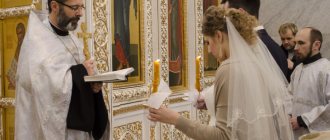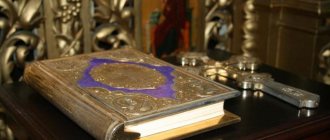Today there are two known Orthodoxies: theological and folk. And if the first refers to the official dogmas and guidelines of the church, then the second is more like a faith based on Slavic paganism. Paganism is studied in school during history lessons, where they tell how everyone who lived in Europe and the CIS countries previously worshiped the Slavic gods.
Today the main church in Russia is the Orthodox Church, but it also has some pagan traditions, which the priesthood itself does not deny. How does traditional Orthodoxy relate to Slavic paganism?
Pagan history of Rus'
Everyone knows the Slavic gods Perun, Dazhdbog, Svarog, Yarilo and others thanks to their popularization among the people through films, videos and commercials. For example, Yarilo became the representative of an entire kvass brand. This is due to the so-called neo-paganism that is popular today - a movement whose goal is to reconstruct Slavic paganism and its rituals, popularizing them in society.
A little about the history of the Church:
- Union of Florence
- Stoglavy Cathedral
- About church councils
Worship of pagan gods
Before we deal with this, we should remember who and what our ancestors worshiped.
A person needs faith without realizing it. Before the arrival of Christian preachers in Rus' (according to legend, this was the Apostle Andrew), people worshiped a whole pantheon of Slavic gods, among which were the gods of thunder, rain, wheat, family, water, etc. In fact, man, not knowing anything about the True and One God , worshiped something incomprehensible - the forces of nature.
Today, even a 5-year-old child will say that thunder is the result of the collision of electrons and a sharp increase in atmospheric pressure, but in the past people believed that it was the god of thunder who was angry. Trying to appease phenomena they did not understand, people began to worship the forces of nature.
Salvation replaced Slavic paganism only in 988 AD. e. when Prince Vladimir converted to Christianity and destroyed the entire rich pantheon of Slavic gods.
For more than 1000 years, throughout the territory of the former Kievan Rus and the Muscovite kingdom, people have been confessing the true God - the Lord Jesus Christ, as well as the Holy Trinity. But despite this, there are people (supporters of neo-paganism) who want to return the worship of natural forces and other pagan traditions to modern life.
Poorly understanding the whole concept of this (after all, history today does not give people a complete picture of those times and they have to simply guess about many things), they prefer to simply invent certain things. Therefore, the movement is chaotic and filled with fragmentary and unclear things.
What advice do people really expect from a priest?
Actually, they expect this not from us, the clergy, but from God. And we just have to tell you how to do it correctly, where to put candles, where to cross yourself, where to bow, etc. For such people, God is exactly like you and me - a passionate being, and therefore we are completely dependent on His whims and moods. Who wants to fall out of favor with the Heavenly King? Naturally, no one. So we please Him, just as we would please an earthly king if we were to fall out of favor and suffer. In the same way, by the way, we please officials, bosses, and those in power. We pay bribes, try to get a position and, in general, get the best life possible. And it even seems to us that exactly the same laws and rules apply in the “office” of the Heavenly King.
In theological language, this phenomenon is called “anthropomorphism” * - this is a situation when we transfer our passionate, earthly ideas to the realm of the Divine presence, and we liken God Himself to a being endowed with power like an earthly king or khan. According to the apt remark of the Apostle Paul, in this case we serve the creature instead of the Creator. Actually, this is the essence of paganism - to serve the creature instead of the Creator! So the “white magic of the Orthodox rite” is paganism in an Orthodox wrapper. This is a situation where secondary, ritual things come to the fore, and the very essence of the Christian faith is completely ignored. Try to tell people with similar ideas about Orthodoxy that God does not punish anyone, that people themselves punish themselves with passions and sins, that the apparent punishments of God are actually good and a manifestation of God’s love for man, quote St. Anthony the Great: “God is good and does only good; harming no one harms anyone, being always the same” - and you will be considered an ignoramus who knows nothing about spiritual matters. Or try writing on Facebook that the Church of Christ cannot serve anything corruptible, temporary, or transitory (neither Ukraine, nor Russia, nor the European Union), that a Christian cannot be a nationalist, and that the highest value for a Christian can only be Christ and His Holy One Church. And you will immediately be listed as “enemies of the Ukrainian people” and “servants of the Kremlin.”
Mixed traditions
Slavic gods and their worship did not pass completely without a trace. Despite the 1000th anniversary of the history of Christianity on the territory of Rus', pagan traditions are strong and continue to live in society.
Spread of Christianity in Rus'
An example is the holiday of Christmas. According to official data, Jesus Christ was born in the summer or early autumn (data based on seasonal phenomena described in Scripture), but Christmas is celebrated throughout the winter.
The fact is that during the Roman Empire, the cult of the sun was very popular, part of which was the holiday of the winter solstice - the longest day of the year. Paganism became a serious obstacle to the spread of Christianity, especially since it affected all levels of society and especially the poor, while the supporters of Christ came from a higher class of the population due to circumstances.
Emperor Constantine, having adopted a decree on the equality of Christianity among other religions, and having himself been baptized, began to look for ways to spread this religion. And the winter solstice holiday was replaced by Christmas. Thus, the pagan holiday acquired a completely new meaning and became the reason for the active growth in the number of those professing the true Lord.
This process is called sublimation - the purification of old rituals and the introduction of new meaning into them. You can find many examples in the modern church when the Synod decides to leave tradition, so as not to give rise to quarrels and division, but introduces a new Christian meaning into it.
Another such example can be the Maslenitsa holiday.
This is an ancient pagan rite of farewell to winter and invitation to spring, which was celebrated and during which tribute was brought to spring for a successful agricultural season. It is clear that this cannot have anything in common with Christian traditions and beliefs. Since this was already a native tradition for people, the Orthodox Church decided to modify or sublimate it.
Burning an effigy on Maslenitsa
Since its celebration coincides with the beginning of Lent before Easter, the priesthood decided to leave the celebration with pies and pancakes as the last one before the start of Lent, during which one cannot allow oneself anything extra from food or festivities. The doll that is burned on this day has become a symbol of sinful flesh, which man crucifies and destroys through prayer and fasting.
So, pagan traditions have a place in modern Orthodoxy, but with a radically different meaning, on which it is necessary to focus.
If you please God, will life get better?
And indeed, a pagan does not need all this and does not understand it. The pagan firmly believes that if you please God, life will improve and problems will be solved. That is why they go to church in search of some kind of magical ritual, formula, prayer mantra, the implementation or reading of which guarantees one hundred percent success.
The pagan does not care about the fact that magism in the Church, first of all, distorts the relationship between man and God, distorts the very thought of God, because the magical point of view is built on the basis that God only needs a ritual that is performed correctly and on time; Otherwise, man does not owe God anything, and the relationship between man and God is completely exhausted by this. Moreover, these relationships themselves are built on such human vices as hypocrisy and people-pleasing, which gives rise to the corresponding spirituality, and with it the paradoxes of our society, when in a country with 80% of Orthodox people, bribery and intolerance towards each other flourishes.
And yet, in a sense, the pagans can be understood, because. very often it is not always easy and comfortable for a person to be with Christ. He commands: You shall love the Lord your God with all your heart, and with all your soul, and with all your mind, and with all your strength - this is the first commandment (Mark 12:30). This requires moral tension from a person, aspiration of the heart to the Lord, and for people this is inconvenient, boring and uninteresting: “They need,” writes St. Ignatius Brianchaninov - effect and entertainment; therefore, Christianity is “colored” with a wide variety of things, such as: visions, signs, revelations; trips in search of visionary elders and oxbows; veneration of various sources and other “shrines”; calculating signs of the imminent end of the world; the creation of a huge number of legends about certain revered saints, etc. Paganism is often mixed in here, clothed in church clothes, for example, the veneration of Honey, Apple and other “Spas”, Maslenitsa, various kinds of semi-superstitious customs associated with the holidays of Christmas and Epiphany, and so on. The danger here is that the teaching of the Church is not the Holy Scripture, not the dogmatic and moral patristic Tradition, but historically flawed information and old women’s fables (1 Tim. 4:7).”
Orthodoxy and paganism: comparison
What do paganism and Orthodoxy have in common? Any religion is about worship, this is, of course, a common feature between them, but in Orthodoxy people worship the True and Living God, and in paganism - the forces of nature, which are clothed in mythical characters.
In Orthodoxy, the Lord is a Person possessing divine traits, but in paganism the gods are in conflict, there are constantly skirmishes or wars between them, they are no different from people. The god Perun had a middle name - Prorva, so people emphasized that no matter how many sacrifices were made to him, it would still be of no use, unlike the dumb and stupid gods of the ancient Slavs, the Lord Jesus always hears people and answers their prayers.
In Orthodoxy, people worship the True and Living God
There are many differences between these two branches, but the main thing is that paganism involves sacrifices (sometimes human ones) in order to appease the god. The Heavenly Father does not require any sacrifices; he sent his Son as a sacrifice for people. And only He is worthy of worship . And paganism is an outdated ancient belief in something that could not be explained to uneducated people.
“Symptoms” of the manifestation of pagan consciousness in popular Orthodoxy
Pantheon of Gods . The saints, who are often addressed “instead of” God, have become completely self-sufficient “gods” in the pantheon of “popular Orthodoxy.” Hence the division of saints “by functionality”, by analogy with pagan deities: it is absolutely important to understand who to pray for what. Prayer to the “responsible saint” is considered more effective. Simply praying to God is incomprehensible and scary, and therefore ineffective.
"Shrines" . endowing objects with independent sacred value. All kinds of “shrines” are perceived as a source of “miracle”. Icons, relics, “land” and other attributes, which for Christians are only objects of reverent veneration, become in “folk Orthodoxy” a “magic wand” that can get rid of all troubles.
Again - regardless of your own efforts and Christ. It’s the same with notes, candles and prayers – actions and words that are incomprehensible to most are distorted and perceived as valuable “spells” in their own right (for example, the distorted 90th Psalm – popularly known as “Living Help”).
Ritualism . As it was said, for paganism, observing the ritual in small things was the key to success with the “higher powers.” In “folk Orthodoxy” this is expressed in observing the letter of the Church Charter without comprehension and faith.
At the same time, any deviations are categorically condemned. Hence the love of ceremonies (“Weddings are beautiful”), the frantic observance of everyday traditions (“On Easter, Easter cake and eggs must be blessed!”) and superstition (“You need to take communion so as not to get sick,” “Blessing your car to prevent accidents”).
The understanding of the relationship between God and man is completely distorted: personal, “filial” relationships (which is the essence of Christianity) are impossible here. Formal ones arise: instead of moral efforts and spiritual growth, there is pleasing the “god” through the fulfillment of certain external rules.
The future: and to each there will be according to faith
As for the future here on earth, as I already said, Christians have understood human nature too deeply to believe in utopian ideas such as communist or neo-pagan about building an earthly paradise in a single country or region. They believe that the end of the world will happen (when it is unknown and not important), the main thing is that everyone will have to answer for their life before God. Heaven and hell are not a place (like the upper and lower worlds) but a state. Time will end, and each of us will be left with what we were looking for. Those who thirst for God and His Truth will find bliss. Those who sought earthly blessings will remain in an eternal search for the unattainable. God does not force anyone to come to Himself. Anyone who did not want to know Him here will not recognize Him there either.
Andrey Kuraev noted: “Spiritual breakthroughs remain in history when one or another culture acquires a higher level of spiritual values; and disasters remain in the memory when people change the main theme of their lives and begin to try on different and lower standards.” This is our story. But we must remember that by making our choice today, we determine not only our personal destiny.
In her book “Paganism in Orthodoxy,” religious scholar G.A. Nosova notes that since the beginning of the Christianization of Rus', there have been two forms of Orthodoxy: preached by the church and real mass religious consciousness, the Orthodox-pagan syncretic complex. Christianity in the Greek-Byzantine version was available only to selected theologians and ascetics. In fact, in Holy Rus', throughout the entire history of baptism, Orthodox paganism, or dual faith, existed in the most unexpected, exotic forms.
Russian Orthodoxy inherited and adopted the cult of pre-Christian patron deities, replacing them with the faces of saints. Ancient pagan holidays received new names and over the centuries began to be considered Christian.
Despite the barbaric eradication of the foundations of national thinking, the Russian people for a long time preserved the Vedic tradition of honoring the four material fundamental principles of the Universe - the celestial elements, fire, water and the mother of the raw earth. And the best examples of folk poetry convey to us a conversation between the human soul and the soul of nature: with a wild wind, a clear month, a red sun, a fast river.
Philosophical thought in medieval Rus' was anti-Christian. From the very beginning, philosophy was a “heresy”, the antithesis of the official ideology. The basis of the cultural-historical process is always national. Borrowing is the inclusion of elements of a foreign culture into the existing structure of the national culture. Researcher of ancient Russian manuscripts A.F. Zamaleev came to the conclusion that “folk paganism seriously modified the most important rituals and dogmatic laws of Christianity... Gradually the Russian people adapted Christianity to their needs, significantly transforming it.” “Pagan thought, the Russian idea of good and evil penetrated into Christian sermons and instructions, thereby determining the originality of Russian Orthodoxy. The ideal of Christian piety (fasting and prayer) was contrasted with the ideal of moral life: help, mercy, sympathy, honesty, generosity, which was later attributed to Christianity, but essentially belongs to the genius of the Russian people.”
Yaroslav the Wise (1015 - 1054) created a literary center at St. Sophia Cathedral. Elements of Greek-Byzantine culture and philosophical knowledge penetrated into Rus' through translated literature. The Slavic prince intended to proclaim the independence of the Russian Church from Constantinople.
Russian thinkers and scribes independently mastered and applied the ideas of ancient authors in their work, sometimes translations of ancient teachings were supplied with “tales” - critical comments. In his book “Philosophical Thought in Medieval Rus'” (L.: Nauka, 1987), A.F. Zamaleev examines the texts of such authors as John the Sinner, Vl. Monomakh, Kirill of Turov, Daniil Zatochnik and others. Thus, in the “Izbornik 1076” John the Sinner boldly engages in ideological reworking of Byzantine texts. For example, the call to monasticism and withdrawal from the world is replaced by advice to show mercy and help one's neighbor. The “Izbornik” was intended for the laity and called for moral renewal.
Byzantine icon painting among Russian artists underwent modification due to “pagan joy of life.” The best works of icon painters of Russian schools are distinguished by expressiveness of color and spirituality of images. The design features of Russian churches were unknown to Byzantine construction practice and go back to national wooden architecture.
The culture of joy, which was supported by Slavic priests, developing scripts for folk games and creating lyrics, became a target for Christian preachers. Mass celebrations and holidays, described by the monks in offensive terms, show the love of the Russian people for “fun”. Participants in folk rituals became familiar with their native history, their tribe, and the surrounding nature.
From time immemorial, culture has been called upon to unite people, to form full-fledged individuals, a human community (by sympathy, co-thinking, assistance). The folk cult of laughter manifested itself in festive amusements and dressing up. The laughter culture of the Slavic people was aimed at overcoming the influence of dark forces and glorified the victory of eternal life over death. Liturgical church chants were processed in everyday life in a parodic, satirical spirit, acquiring a free interpretation. The performances of buffoon jugglers included parodies on themes from the Old and New Testaments.
In the deep layers of Russian national consciousness (fairy tales, songs, legends) the tradition of personifying natural objects has been preserved: rivers, sacred trees, stones and celestial elements. The singer and storyteller asked them for protection and strength. Spiritualized animals and birds also help good people in difficult times - the prophetic heroic horse, the wise cow endowed with mystical powers, the soothsayer raven, etc.
The Slavs turned to higher powers with requests for protection from all sorts of troubles and the granting of happiness. The red sun, stars and bright moon were protective symbols, amulets from evil spirits. In Russian conspiracies we read: “I will go to an open field - under the red sun, under the brightening moon, under frequent stars, under flying clouds. I, God’s servant, will stand in an open field on a level place, on the throne of my Lord, I will be clothed with clouds, I will be covered with the heavens, I will put the red sun on my head, I will gird myself with bright dawns, I will wear frequent stars, like sharp arrows - from all evil ailments.”
According to conspiracies, violent winds carry misfortunes beyond high mountains and dense forests, dispel melancholy. In A.N. Afanasyev we find confirmation that “Russian fairy tales, songs and conspiracies are filled with appeals to the winds with a request for help, as living creatures and ready to help out in trouble.” “The wind is the spirit of God,” states the Galician proverb, in accordance with the ancient Indian concept of winds as the breath of Varuna (cloudy sky),” writes A.N. Afanasyev in his study. We further read that the winds help the thunder god in battles with demons and use his battle arrows. The Hindus gave the god of the winds, Vai, the epithet Indrasarati, that is, Indra's companion in arms. In the Vedas, the divine representatives of the winds are called Maruts. Dressed in shining armor and armed with bows, they rush through the air in chariots drawn by light-footed antelopes. Intoxicated by the honey drink, the Maruts madly rush into battle, give free flow to the rain springs and sing a thunderous song of praise.
The continuous spiritual activity of our ancestors is vividly described in the book of the famous 19th century folklore collector Sergei Maksimov, “The Unclean, Unknown and Cross Power” (M.: Kniga, 1989). The conspiracies, signs and customs of our great-grandfathers were based on working with words. They reveal to us relict layers of national consciousness.
Thus, Orthodoxy never embraced all aspects of the mental activity of the Russian people and did not subordinate their spiritual interests. That is why, on the “bright” night before Christmas, bonfires were lit near churches throughout the vast expanse of Great Rus'. The lighting of living fire (svarozhich) was carried out by friction, four times a year. Bonfires marked the solar phases - the days of the solstices and equinoxes. Since ancient times, fire was considered a connecting link between the earth and space and was used as a carrier of sacrifices to the cosmic gods. This tradition is an echo of Vedic sacrifices and requests for protection and well-being.
Sergei Maksimov testifies that all such sacred rites were passed down among the people according to the will of his great-grandfather. In ancient times, the corner stove column was given anthropomorphic features - it was the grandfather of the house. From this pillar, by rotating a spindle in the astragalus, “living fire” was extracted. Live fire produced by friction was used to protect oneself and livestock from widespread diseases. To do this, they jumped over the fire, dragged the sick over it and drove away the cattle. In addition to living fire, Russian people attached great importance to sacred fire. This is the fire taken out of the church after the great holidays (temple fire) and received special power and exceptional grace.
It was believed that the shepherds would keep their flock if wax from an Easter candle was rolled into the horn. The Thursday candle, with which they stood in front of the altar on Holy Thursday, is capable of protecting during a thunderstorm and destroying the spell of evil sorcerers. It was used to burn crosses on the doorposts and windows so that evil spirits would not visit the home. You can still find fiery crosses in the huts of Russian villages. Reverently believing in the mysterious power of fire, the native Russian never doused the fire with water, did not touch it with a knife, did not throw hair into a flooded oven, did not extinguish the fire in the fields and at night, leaving the fire to go out on its own. The home fire was lit with prayer and extinguished with prayer.
But since ancient times, special importance has been attached to the cleansing and magical power of water. The cult of water was manifested in the custom of bathing in clean springs and springs. The water from these springs was considered divine grace, which is why they were called “farewells.” A person who bathed in simpler waters came ashore forgiven, that is, clean physically and spiritually. Chapels were built near the proscha, gifts and offerings were brought to these springs from all sides, and games and markets were held near them.
The cult of water has survived to this day. Every believer tries to obtain Epiphany consecrated water in order to protect themselves and their loved ones from illnesses and damage. In the Ryazan region, I had the opportunity to observe two women bathing in a forest, icy spring for healing from illnesses. This place was known to their great-grandmothers. They believed in the magical power of the spring. In these same places, healers use the cleansing power of holy water (temple water) to remove the “evil eye”. People and livestock are washed with it, the corners of the house and spring crops are sprinkled with it. At the same time, spells are pronounced, just like in pre-Christian Rus', when cloud-dispelling priests dispersed clouds or called upon clouds.
The ability of water to transfer information was perfectly mastered by sorcerers, soothsayers, kobniks, and healers. With the help of water they learned about upcoming events and what happened in the past. Traditions of deep antiquity also tell about the Slavs’ faith in the power of living and dead water. Charmed water infused with herbs was used to cure illness. Russian healers still use Ayurvedic treatment methods today, often without knowing it (Ayurveda is the science of life, part of the Vedas, containing knowledge about the treatment of the human soul and body). In their arsenal of fighting diseases, not only herbs, oils, earth, water and the element of fire, but mainly, verbal appeal to invisible healing forces.
Sergei Maksimov says: “... it has always been the custom that it is very wise to trust the power of healing potions if they are not spoken in advance or whispered right there in front of the patient, since the main power of healing lies in the words of the conspiracy, and potions serve only as a sedative and sedative. . That’s why healers are called “whisperers,” precisely for those spells or mysterious words that are whispered over a patient or over a drug. Conspiracies are perceived either orally from teachers, or from written records, abundantly distributed among the literate rural population under the name “flower gardeners,” “herbalists,” and “healers.”
The fourth world element - earth - was called mother by all peoples. A.N. Afanasyev writes: “In almost all languages the earth is given feminine names. The hymns of the Rig Veda represent Heaven and Earth as an immortal married couple... The word matar among the ancient Aryans had the meaning of “producer”, from the root ma - to create.”
From Sergei Maksimov we read: “According to universal belief, this very element is so holy and pure that it does not contain anything unclean and especially hostile to people.” The soil from parental graves is considered sacred; it saves living relatives from all sorts of troubles and misfortunes. When going to a foreign land, a Russian person took with him a handful of his native land, believing that it would protect him from illness and from homesickness.
A special attitude towards the raw mother earth was expressed in respectful bows to the ground and kissing the earth. Back in the 19th century, harsh oaths and vows were sealed by kissing the cross and eating a handful of native soil. Russian peasants resorted to the intercession and patronage of their “nurse” to protect themselves from the spread of epidemic diseases. To do this, at night, in a mystical atmosphere, a ritual of plowing the village was performed in order to protect people and livestock from all sides with a “mysterious, enchanted belt of earth, cut with a plow, the width of a plowshare and a depth of at least three inches.”
Spring sowing of the land was carried out by the whole world with candles and prayers. After sowing, the ground was sprinkled with holy water. This tradition is a vivid example of the custom of starting any business with God's blessing. It has been passed down from generation to generation and undoubtedly has Vedic roots.
A.N. Afanasyev also points out that the Russian word “shepherd” has a Sanskrit root: “...Sanskrit. go-pa - first: shepherd, and then: ancestor, king; from Skt. the roots pa (mouth) come from: Pan - the god of shepherds among the Greeks and Romans; the Slavic pan is a lord and a shepherd - not only a shepherd, but also a priest and a king, as shepherds of the people.”
In the Christian era, the place of the cattle god Volos was taken by St. Vlasiy. Throughout Russia, villagers prayed to St. Blasius about saving livestock and on the day of his memory (February 11) they drove the cows to the church, served a prayer service, sprinkled them with holy water and gave them crumpets with milk porridge to eat. At the same time they brought cow butter to the temple and placed it as a gift in front of the image of St. Vlasiya. Since St. Blasius was also considered the patron saint of farmers; offerings were made to him in the field: the reapers curled a bunch of mature ears of grain “for the hair of the beard,” that is, they sacrificed to him a bush of golden ears of bread. During this action, ritual songs were performed. At home, in front of the shrine, a sheaf from the new harvest was placed - novina.
Whatever area of life of the Russian people we examine, everywhere the sprouts of ancient pagan traditions inexorably make their way, which are the backbone of the people, their amulet, the pure spring of primordial wisdom.
Print version (or PDF)











